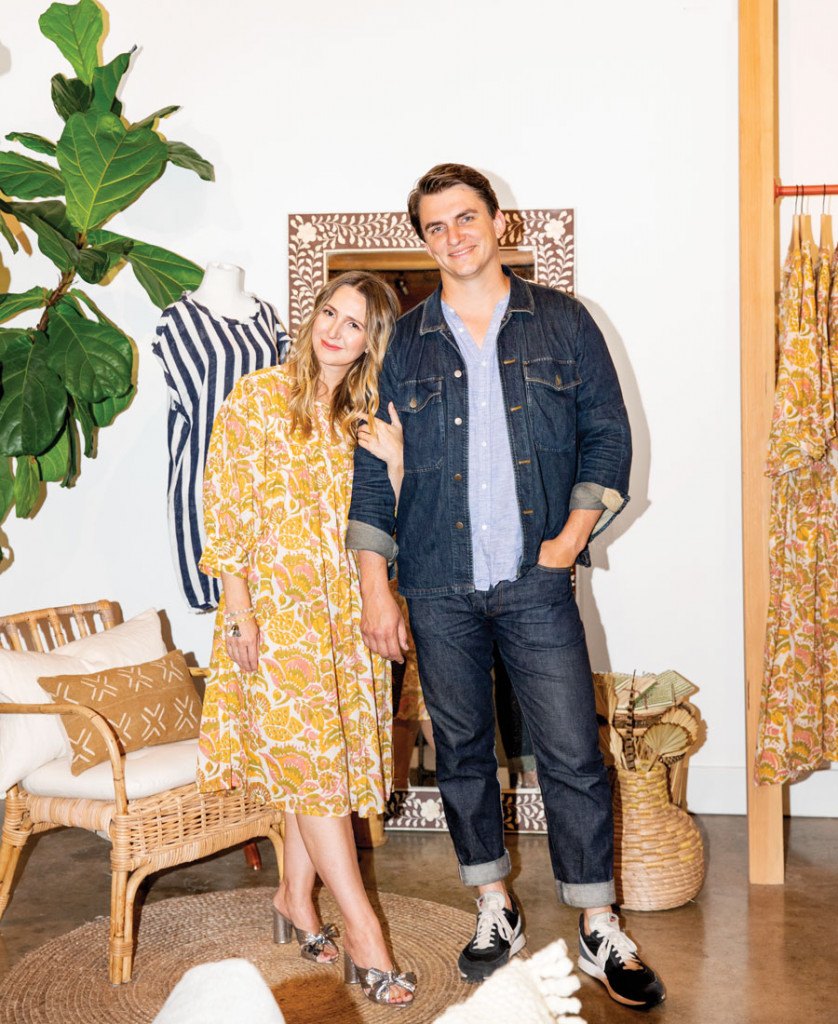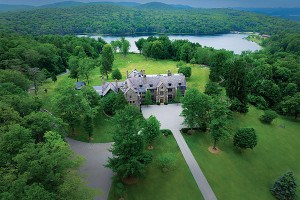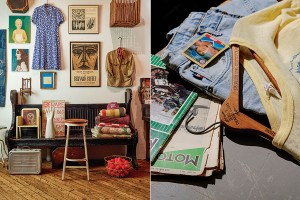The Philly Power Couple That’s Quietly Nurturing the City’s Creative Class
How Amy and Leo Voloshin — of Printfresh Studio and an eponymous clothing line — are expanding their beloved brands into an empire.

Amy and Leo Voloshin in their new showroom. Photograph by Jillian Guyette
Leo Voloshin is bleeding. Well, he’s not bleeding right now. But he was. He has four stitches in his right thigh, incurred last week when a 10-foot steel beam he was trying to install in the courtyard of Kensington’s Jasper Studios toppled, ricocheted off the cement in the parking lot, and gashed him.
The wound was two inches from his femoral artery, which was potentially fatal but mostly inconvenient — he and his wife and business partner, Amy Voloshin, had to be in New York that day for the Phoenicia Flea Market, a hip maker emporium at which the couple sells merch from their popular Philly-based clothing and stationery lines.
I’m hearing the story from Leo, 37, a week later, as we stand at a window on the top floor of Jasper, the 80,000-square-foot warehouse the Voloshins have remade into artist studios. We’re gazing down at the aforementioned piece of metal, now fixed innocuously upright in a courtyard that’s not quite a courtyard yet. The square will, I’m told, be a flower-bedecked gathering space for the makers who rent offices here.
“We have a lot of photographers and fashion people hosting events or photography clinics,” says Leo. “So we thought it’d be nice to have a space for people to hang out in while they wait.” As for the office we’re standing in, it could be a poster for industrial-chic design: warm wood floors, exposed brick, tan leather couches, a ping-pong table in front of double-height windows. (The Queer Eye team considered filming their Philly loft hangouts here, but there were always too many people around to keep the news from getting out.)
Amy, 38, is in the kitchen behind us, chatting with a designer — one of dozens of employees on this floor who constantly flit to her with questions. The coffee grinder whirs in the background, and a minute later, she hands me an espresso in a tiny ceramic cup.
Over the past 15 years, the Voloshins have become major players in building up Philly’s increasingly vibrant creative and maker scene, in part by starting their own successful businesses here, including Printfresh Studio, a flourishing textile design outfit for the fashion and home industries, and Voloshin, their feminine, bohemian clothing line. Their impact, however, is larger than just their own companies: As budding developers and event planners, they’re also building work spaces for other local creators and artists.
Their first development, Paper Box Studios, on a now-bustling corridor off Cecil B. Moore near Front Street, started as a long-shot pipe dream before becoming a haven for makers, creatives, and even bespoke wellness and fitness studios. Their second renovation, Jasper Studios, also contains all manner of eclectic talent: artist-in-residence painters, fashion phenoms, in-demand local photographers, furniture builders, designers of restaurant interiors, plus their newly opened Voloshin clothing-line showroom. On top of that, the Voloshins have launched sample sales featuring merch from their companies and other local designers at their headquarters, along with curated events like the now-twice-annual Fishtown Flea market, a maker market that brings indie designers and creators out of the studio and onto the block.
They’re makers themselves, sure, but the Voloshins are something more: a catalyst for creativity in Philadelphia. And if you ask them, they’re just getting started.
Amy Voloshin, a pretty hippie with wavy caramel hair parted down the middle, breezes around in self-designed organic cotton gauze silhouettes. It’s no wonder she’s the face of her travel-inspired clothing brand (Voloshin) — her team regularly posts social media images of her donning the latest designs. Leo, by contrast, is often wearing dark blue and denim and carrying power tools. He has a wide, friendly, structured face — the type of person you’d ask for advice, which his tenants often do.
Amy, the design powerhouse, and Leo, the operations guy, launched Printfresh Studio in 2006. Over the years, the company has grown into a formidable world leader in a very niche field: dreaming up the patterns and shapes you see on clothes at the mall, online, everywhere. (Their inspiration-sparking collection of vintage textiles and their original prints are incorporated in everything from Diane von Furstenberg, Givenchy and Macy’s clothing to Target bathing suits and duvets.) Last year, Printfresh Studio sold more than 4,000 prints that have been emblazoned on millions of items around the world. No surprise, then, that the company has been included on Wharton’s list of the 100 fastest-growing firms in Philadelphia, or that Amy was named Young Entrepreneur of the Year by the Greater Philadelphia Chamber of Commerce in 2015.
But the Voloshins didn’t just want to make prints for other brands; they wanted to design their own stuff, too. In 2017, the couple launched both Voloshin, their line of upscale yet effortless clothing, and their line of crushed velvet notebooks and textile-inspired stationery, called simply “Printfresh” after their first venture. These are international operations — the clothing and notebooks, sold all over the world, are made in India. Amy travels frequently, to meet with the mostly female factory owners she works with overseas and to find new embroidery and color inspiration to bring back. (Coral is totally the color of the year, she tells me.)
Though on disparate paths, Amy and Leo were both groomed from childhood for what they do now. Amy’s parents met when they were working at Knoll furniture company in Montgomery County, then left to found their own industrial design company, which later became Eldon Design Associates. “Their studio was where I felt most comfortable,” says Amy. “It’s what I wanted for my work experience as well — to be able to design the culture and space that I work in.”
Leo, in contrast, grew up in Kiev, Ukraine, in an increasingly unsettled USSR. He slept on a family friend’s couch in Moscow after the Chernobyl nuclear disaster; soon after that, his mom was questioned by the KGB for political comments. When he was seven, his family fled to the U.S., eventually landing in Northeast Philly. They were allowed to leave Russia with only $750 and whatever trinkets they could carry.
“You bought all this stuff — binoculars, watches, matches, fancy crafts — so that while you’re waiting in Europe, you can sell it off and have some money to live,” he explains. “So every weekend” — Leo, co-founder of the Fishtown Flea market and a regular at other area markets, pauses as he slowly makes the connection between his past and his present: “It’s funny that I say this out loud now, but we would go to the flea market in Rome and sell things.”
Leo and Amy met through a circle of creatives in Fishtown when they were both younger. Amy worked for Free People in the days before URBN’s sprawling Navy Yard campus, then moved to New York, splitting time between there and Philly as the couple worked on their first business, a t-shirt design company called MoonBlood.
“We were dyeing t-shirts in our washing machine in our apartment,” Amy remembers, laughing. Things started to take off in 2006 when Amy moved back and the couple launched Printfresh Studio. Four years later, business was booming, and they’d outgrown the small space they’d rented for their fledgling company. A chance encounter led them to buy and revamp the warehouse across the street from them in Fishtown, creating a new space for themselves — and many additional studios — in what would become Paper Box.
“We had never done any renovations before that,” says Amy. “We hadn’t even renovated our kitchen yet.”
“We both felt there was a need for more artists’ space in the neighborhood,” says Leo. “And being an immigrant coming here when I was little, with just my parents and, like, $700, I’ve always wanted to create opportunities.”
Philly, once the “Workshop of the World” and a leader in textile weaving, now has seemingly endless unused factories ripe for transformation. These buildings, which formerly represented Philly’s industrial prosperity, now signal potential for a rise of the arts. Over the past decade or so, converted artist studios have been proliferating from Fishtown to South Philly: Viking Mill, Maken North and South, BOK, Jasper, Paper Box. They house hundreds of artists and independent makers as well as creative businesses with the potential to contribute significantly to Philadelphia’s economy.
There are negative aspects to those retooled warehouses in certain neighborhoods, of course — gentrification means housing prices eventually shoot up, potentially pushing out older or low-income residents — but there’s also an excitement and ambition and energy in Philly in the past 10 years that’s attracted a new creative class.
Today, Amy and Leo’s son Nico, seven, and daughter Mila, five, attend the Adaire Alexander School in Fishtown. Amy and Leo donate a portion of Printfresh profits to art and mindfulness programs for schoolchildren and recently installed new lighting in the Adaire classrooms.
Meanwhile, Paper Box Studios houses 22 offices and a garden courtyard. Tenants include Groundswell Design Group (which has designed city outdoor spaces including Spruce Street Harbor Park, Cherry Street Pier and Winterfest), DollFace photography, and acupuncture and reiki healing spot Haven Wellness. The building sits at the corner of Hancock and Turner, just off Cecil B. Moore Avenue. It’s a rapidly developing neighborhood near popular spots like Evil Genius Beer Company and only blocks from restaurant darlings Pizzeria Beddia and Wm. Mulherin’s Sons. “Eleven years ago, the area was not cool,” says Leo. “People would ask us, ‘Why are you there?’ It was about taking a risk and seeing the possibilities.”
Jasper Studios, their second development project, is a huge former carpet mill from the late 1800s; the Voloshins partnered with local developer Nate Krauthamer to afford the building. It’s now home to 50 spaces filled with the likes of Rohe Creative, Emily Wren Photography, Dilo candles and scents, Norman Porter Co., and Lovello Elizabeth, as well as two spots dedicated to residencies for up-and-coming visual artists, who each get three months of free studio space. Both buildings have become highly coveted among creative types — there are waiting lists — who are as interested in rubbing elbows with the community of artist-tenants as in the physical spaces.
Back in the studio, Amy walks me over to a mood board for the latest Printfresh collection; a co-worker mentions that Voloshin belt samples have come in from India. I follow as Amy goes to take a look at the product, comparing the braided leather in her hands to the specs sent to the factory. They don’t exactly match up.
“It needs to be softer, less thick, so it hangs loosely,” Amy says.
The changes are noted, and she’s on to discussing plans for June’s Fishtown Flea, which will feature more than 40 local vendors, including some of the couple’s tenants. Apparently, the market’s Shackamaxon Street neighbors were never alerted about the big shopping party on their block, so Leo and Amy are distributing drink tickets and preemptive apologies for traffic. Then Amy’s off to a meeting for a brand collaboration. Nico is buzzing around the office, weaving through the rainbow of fabric samples; Leo invites him to come along to take a look at another Kensington factory to potentially turn into artist studios.
I tell Leo and Amy they seem to be doing a million different things at once. “Yeah,” Leo says, “maybe one day, we’ll just be doing one thing.” I nod. But I don’t really believe him.
Published as “The Makers Behind the Makers” in the August 2019 issue of Philadelphia magazine.


